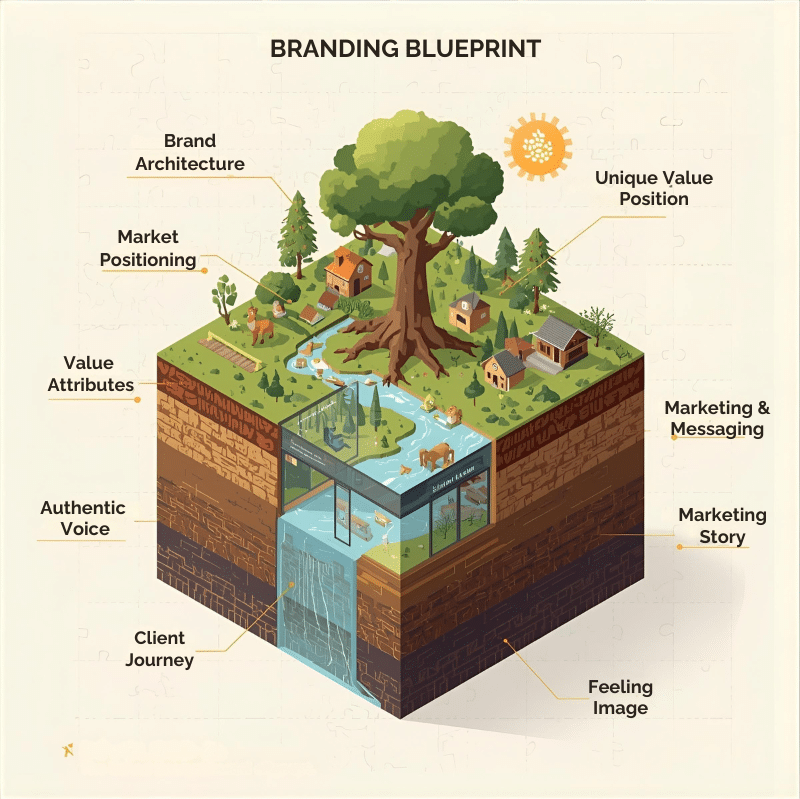Let’s talk about one of the biggest misconceptions I see in business today. You’ve invested in a beautiful logo, maybe even a full visual identity package, and you think you’re done with branding. I get it – there’s something satisfying about checking “branding” off your business to-do list.
But here’s the thing: what you’ve completed is just one piece of a much larger puzzle. And as someone who’s spent decades helping business owners build sustainable, profitable enterprises, I can tell you that this misunderstanding is costing you clients, revenue, and growth opportunities.
Your brand is like creating a comprehensive business ecosystem. That logo? It’s important, but it’s just one element in a system that, when properly developed, becomes your most powerful business asset.
Understanding What Branding Actually Encompasses
From a strategic standpoint, your brand represents the sum total of every experience, impression, and interaction someone has with your business. It’s the promise you make to your market and the consistent delivery of that promise over time.
Think of it this way: when someone mentions Apple, what comes to mind isn’t just their logo. It’s their entire approach to design, their customer service philosophy, their product innovation, and the feeling you get when you use their products. That’s a complete brand system at work.
For your business, this means every touchpoint – from your website copy to how you handle client concerns – either strengthens or weakens the perception of your brand. There’s no neutral ground here.

The Strategic Foundation: Building on Solid Ground
Before any visual elements come into play, you need what I call your brand architecture. This is where we get methodical about defining your market position, your unique value proposition, and your competitive advantages.
Your brand strategy should answer these fundamental questions: Who exactly do you serve? What specific transformation do you provide? Why should someone choose you over equally qualified competitors? What’s your distinctive approach to solving their problems?
Without this foundation, you’re essentially decorating a house that hasn’t been built yet. You might create something beautiful, but it won’t be structurally sound or strategically effective.
Developing Your Authentic Voice: The Psychology of Connection
Here’s where my background in both business and human behavior becomes particularly relevant. Your brand voice isn’t just about tone – it’s about creating psychological resonance with your ideal clients.
Are you the seasoned advisor who brings calm to chaos? The innovative strategist who sees opportunities others miss? The supportive guide who’s walked this path before and can show the way?
Your voice should reflect not just your personality, but your professional positioning and the emotional needs of your clients. When someone reads your content, they should immediately sense competence, relatability, and the kind of professional relationship they’re seeking.
The most successful professionals I work with – particularly women and minority business owners who often face additional credibility challenges – understand that their voice must balance approachability with authority. You want to be seen as both competent and trustworthy, expert and human.
Visual Identity: The Science of First Impressions
Now we can discuss visual elements, but with strategic intention. Every design choice should reinforce your positioning and appeal to your specific market segment.
Your visual identity includes your logo, color psychology, typography choices, imagery style, and how these elements create visual consistency across all platforms. Each decision should be based on research about your target market and understanding of how visual cues influence perception and decision-making.
For instance, if you’re targeting C-suite executives, your visual approach will differ significantly from someone serving creative entrepreneurs. The colors, fonts, and overall aesthetic should align with your clients’ expectations and professional environment.
The Client Experience: Where Strategy Meets Reality
This is where many businesses stumble, and it’s often where I spend considerable time with my clients. Your brand experience encompasses every interaction from initial awareness through long-term relationship maintenance.
Consider the client journey: How do they discover you? What’s their first impression? How smoothly can they engage your services? What’s it like to work with you? How do you handle challenges or concerns? What’s their experience after the formal engagement ends?
Each of these touchpoints should reinforce your brand promise and build trust. Inconsistency here can undermine even the strongest marketing efforts. Your clients should never be surprised by a disconnect between what you promise and what you deliver.
The Power of Strategic Storytelling
Your brand story isn’t autobiography – it’s strategic narrative that positions you as the right solution for your clients’ specific challenges. The most effective stories follow a framework: the challenge you or your clients faced, the journey toward resolution, and the transformation that resulted.
This storytelling serves multiple purposes: it builds credibility, creates emotional connection, and helps prospects see themselves in similar circumstances with similar positive outcomes. When done well, your story becomes a bridge between your expertise and their needs.
Integration: Creating a Cohesive Brand System
When all these elements work together – strategy, voice, visuals, experience, and story – you create what I call a brand ecosystem. Each component reinforces the others, creating a compound effect that’s much more powerful than the sum of individual parts.
This integration is particularly crucial for service-based businesses, where trust and perceived expertise directly impact purchasing decisions. Your brand system should consistently communicate competence, reliability, and alignment with your clients’ values and goals.
The Business Case for Complete Branding
From a purely business perspective, companies with strong, cohesive brands command premium pricing, experience higher client retention, and generate more referrals. They also tend to attract higher-quality prospects who are already pre-sold on working with them.
For business owners, particularly those in competitive markets, a well-developed brand becomes a significant business asset. It differentiates you from competitors, builds market recognition, and creates customer loyalty that transcends price sensitivity.
Moving Forward: Building Your Brand Foundation
If you’re recognizing gaps in your current brand approach, don’t worry – this is actually good news.
Awareness is the first step toward improvement, and most business owners go through this realization process.
Start with strategy. Get clear on your positioning, your ideal client profile, and your unique value proposition. Then move through voice development, ensuring consistency across all communications. Visual elements and experience optimization can follow once you have that solid foundation.
Remember, building a comprehensive brand isn’t just about marketing – it’s about creating a sustainable competitive advantage that supports long-term business growth. When you approach branding strategically, you’re not just creating pretty materials; you’re building a system that consistently attracts, converts, and retains your ideal clients.
The investment in comprehensive branding pays dividends in terms of business growth, client satisfaction, and professional recognition. More importantly, it positions you to serve your clients at the highest level while building the kind of business that truly reflects your capabilities and values.
Your logo is just one piece. Your brand is the entire masterpiece.
If you’re ready to stop decorating and start building a structurally sound brand that attracts, converts, and grows your business, let’s talk. Your first strategic session is on me.



